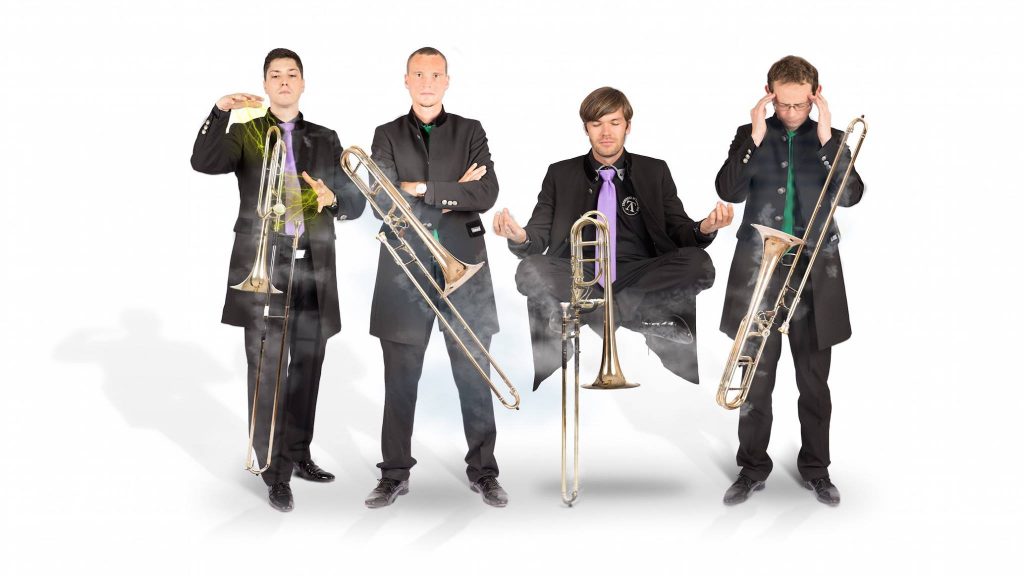The musicologist and journalist Markus Hennerfeind talks with and about Trombone Attraction.
The trombonists of the Austrian ensemble Trombone Attraction devote a great deal of time to the precise composition of their concert programmes. For the four top musicians, merely unwinding, even if it were a good number, would be out of the question. For them, everything is planned precisely because they want to tell real stories and therefore also create choreographies, even developing their performances into real works of art.
"At the beginning of a new concert program, we have a reading rehearsal," the quartet reveals, "at the end there remains a large mountain of notes that we don't play, and a small pile that is shortlisted. It's all about musical quality: "There are an incredible number of arrangements for our instrumentation, but only a few really good ones. However, it is also common for us that we seldom play something just the way it is written in the sheet music: Until we are completely satisfied with a piece, it goes through a process of constant further work and refinement. I wonder if such work is always halfway harmonious. "We make our decisions democratically. Only when all four of us are really happy with a piece do we play it. Sometimes there are already heated discussions, but we have still come to an agreement," the four trombonists affirm with a laugh.
On the one hand, their intimate, friendly relationship results from the long collaboration in the ensemble: the four musicians got together for a first rehearsal in November 2006, and the musical chemistry was immediately right. There, in the cellar of the Wiener Volksoper, began a success story that has now lasted almost twelve years. But of course they were not completely unknown to each other, which is immediately apparent from their biographies.
Now who are these four trombonists? Raphael Stieger, like Stefan Obmann, comes from Carinthia, the first (joint) trombone teacher was Willibald Krupka. Both won prizes and later studied with Dietmar Küblböck at the University of Music and Performing Arts in Vienna, among others; both have played or continue to play in orchestras and other ensembles. While Raphael Stieger is particularly interested in the pedagogical side of his profession as head of the Leopoldstadt district music school, Stefan Obmann works freelance in many different orchestras. Christian Poitinger and Martin Riener are not only classmates of the same year, they also went to school together at the music high school in Linz. They soon mastered the trombone so well that Christian Poitinger first studied in Linz with Friedrich Loimayr and then in Graz with Johann Ströcker, Martin Riener in Vienna with Dietmar Küblböck and Otmar Gaiswinkler. Competition prizes and engagements in orchestras also count among their "good trombone playing". For ten years they played as colleagues in the orchestra of the Vienna Volksoper, in 2016 Martin Riener joined the Vienna Symphony Orchestra.
But let's go back to the first rehearsal in the Volksopernkeller: the collaboration quickly picked up speed, and after the first concerts of Trombone Attraction, the debut CD entitled "Zug um Zug" soon followed, which thanks to its quality further boosted the career. Since then, the quartet has given numerous performances at home and abroad, including in Germany, France, Hungary, Italy (Stresa Festival) and Greece. In 2008 the four of them won the renowned "International Brass Competition Passau". Their second CD ("All Directions") followed in 2010, and their third ("Gezeichnet") in 2015.
The repertoire of Trombone Attraction includes all styles of music and actually excludes nothing. They are also aware of the prejudices their instruments are exposed to: For some, they are regarded as static low-frequency suppliers, who use volume and brazen power to fuel the applause in the final movements of romantic symphonies. At best, the trombone is capable of an incredible range of expressive possibilities. The musicians of Trombone Attraction also see it as their task to "educate taste and hearing here".
Just how flexibly trombonists can play their instruments, how varied the sounds are that they know how to elicit from them, should amaze many people at their concerts.
Markus Hennerfeind
musicologist, journalist

